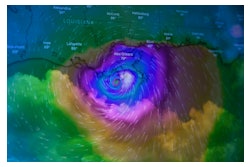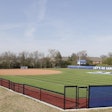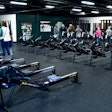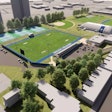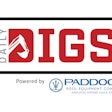Editors' note: In March 2014, students at the University of Wisconsin-Madison approved a $223 million referendum to overhaul the campus recreation facilities, badly in need of improvement. Since then, the recreation program has been busy planning, fundraising, vetting architects and much more. As the project progresses, Alex Peirce, UW-Madison Rec Sports Assistant Director of Marketing and Communications, will be offering an inside look at the process of coordinating such a monumental planning effort.
When Rec Sports ran its first campaign for new facilities, NatUP, from 2009 to 2010, the division faced scrutiny by students regarding the amount of money spent on campaign marketing materials. Because we are mainly student-funded (Wisconsin students pay a segregated fee to Rec Sports each year as part of their tuition), the purchase of campaign marketing materials was somewhat controversial. Though no student money was spent on the NatUP campaign, the perception was still a concern. NatUP did not gain the needed support for a variety of reasons, but in 2012 students approached director John Horn to reopen a master plan and revise a campaign to improve the campus recreational facilities.
As the new coordinator of marketing and communications, I was given strict guidelines as to how I could and could not spend money when we began the campaign in 2013. These restrictions created some initial challenges, forcing us to think creatively about how to bring our message to a campus of more than 40,000 students.
As a division, we pursued a variety of strategies to engage students in discussions about the Master Plan. We outlined a campaign strategy that included education during the fall semester and engagement – or the “push” as we referred to it internally – during the spring semester in the final six weeks before the vote. (I was reading Game Change at the time and based some of our strategy on the successful campaigns of political candidates during the 2008 presidential race.)
The following strategies were some of the most successful means by which we connected with students at little to no cost. Other strategies included email marketing and partnering with the campus communications department, student newspapers and athletics department. Some of our tactics may seem obvious, others revolutionary, and a few potentially tired and outdated (it is, after all, 2015).
Blog:
- Perhaps the greatest communication tool we used was our Master Plan blog where we posted original content about the plan, answered FAQs about the impact on campus, explained controversial topics, and engaged in daily conversation with people. Over the course of the campaign, the blog received more than 100,000 visits and I answered over 400 comments from students, faculty/staff, and community members.
Social media:
- We utilized Twitter and Facebook (we did not yet have an Instagram account and Snapchat wasn’t a thing yet) to increase awareness about the master plan. From tweeting facts about the plan and using our #VoteUW hashtag, to encouraging our student staff (over 700 employees) to change their Facebook profile picture to the campaign logo, we implemented strategies we saw as relevant and sharable.
Video:
- Our creative team created several videos to help deliver various emotions related to the Master Plan. We developed videos that focused on leaving a legacy for future Badgers, the student voice, impact, humor (a parody, which is no longer available but that received over 3,000 views on YouTube, of the Sarah McLachlan animal cruelty video), and the importance of voting in the referendum.
Personal meetings:
- We met with students in both small, intimate settings and large, open forum settings. The purpose of these meetings was not only to educate students, but to engage them in conversation about the new facilities. We wanted to position Rec Sports as accessible, genuine and flexible throughout the process.
Facility signage:
- Relying in part on the marketing strategy used by Burma-Shave in the 1920s, we hung posters throughout our four facilities to educate students about the projects. We made accessible the project timeline, segregated fee information, images of new facilities, answers to common questions, dates of the vote and more. For almost five months, our members could not come into our facilities without being exposed to information about the Master Plan.
The key to our success came not only in how we distributed our message but in how we framed it and were able to mobilize students around it. While the public relations, blog, social media, campus meetings and facility signage served as effective vehicles for our campaign, we would not have been as successful had we not also delivered information that authentically connected with students.
We gauged students’ major concerns based on personal conversations, chatter on social media and questions and comments on our blog. From these discussions, we derived a message that resonated with students because it answered the questions they were asking and used the students’ own language. They wanted to know how much the project would cost, where they could work out during construction, and what would happen if history repeated itself and the plan did not pass. We actually changed the majority of our campaign communication to reflect these concerns, as opposed to the “leaving a legacy” message that we originally thought would be the driving message.
In the end, we spent less than $1,000 on a campaign for a $223 million recreational facilities project, and 87 percent of students who voted on our Master Plan supported it.
If you are embarking on a similar project, regardless of your marketing budget, I hope you’ll find our story encouraging. Listen to your audience and the questions they’re asking. Listen to their concerns and address them, even if the scope of your project can’t satisfy all of them. Share your vision and stay on message, but speak your audience’s language. Educate. Engage. Mobilize.
Building connections takes time -- but hardly any money.
Alex Peirce joined UW-Madison Rec Sports in 2013 as the Division’s first professional marketing staff member. Read more about Alex on the UW Blog Page.















